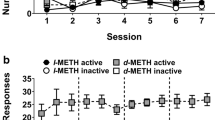Abstract
Magnesium chloride (MgCl2) produces behavioral effects similar to those of psychomotor stimulants in a variety of behavioral situations. Because MgCl2 appears to have stimulant properties, the ability of MgCl2 to maintain responding in a rat self-administration paradigm was examined in seven experiments under different access and schedule conditions in cocaine-trained rats. These varied from the availability of MgCl2 for a single day's test session subsequent to 1 h availability of cocaine, to the availability of MgCl2 for 10 or 20 days after cocaine availability was totally discontinued. Fixed ratio 1, fixed ratio 5, and progressive ratio 1, 2 and 3 schedules of drug delivery were used. The results demonstrate that MgCl2 may substitute for self-administered cocaine because it maintained responding; it did so dose dependently to maintain a constant level of MgCl2 intake; and it did so over a 10-day period of time both with and without access to cocaine on test days. Responding maintained by MgCl2 when cocaine was no longer available was similar under fixed ratio 1 and 5 schedule conditions. The progressive ratio breakpoints for MgCl2 were significantly higher than those for saline, but significantly lower than those for cocaine. These data indicate that MgCl2 has some reinforcing efficacy in cocaine-trained rats, particularly under fixed ratio 1 and 5 schedules, but has a low abuse potential compared to cocaine.
Similar content being viewed by others
References
Boren JJ (1961) Resistance to extinction as a function of the fixed ratio. J Exp Psychol 61:304–308
Brady JV, Lukas SE (1984) Testing drugs for physical dependence potential and abuse liability. In: NIDA Research Monographs, vol 50, edited by the Superintendent of Documents, U.S. Government Printing Office, Washington, DC
Carroll ME, Lac ST (1987) Cocaine withdrawal produces behavioral disruptions in rats. Life Sci 40:2183–2190
de Wit H, Wise RA (1977) Blockade of cocaine reinforcement in rats with the dopamine receptor blocker pimozide, but not with the noradrenergic blockers phentolamine or phenoxybenzamine. Can J Psychol 31:195–203
Izenwasser SE, Garcia-Valdez K, Kantak KM (1986) Stimulant-like effects of magnesium on aggression in mice. Pharmacol Biochem Behav 25:1195–1199
Kantak KM (1988) Magnesium deficiency alters aggressive behavior and catecholamine function. Behav Neurosci 102:304–311
Kantak KM (1989) Magnesium alters the potency of cocaine and haloperidol on mouse aggression. Psychopharmacology 99:181–189
Kantak KM, Adlerstein LK (1990) Enhancement of apomorphine andl-amphetamine induced behaviors by magnesium. Pharmacol Biochem Behav 36:29–33
Kantak KM, Bourg JF, Lawley SI (1990a) Failure of magnesium to maintain self-administration in cocaine-naive rats. Pharmacol Biochem Behav 36:9–12
Kantak KM, Lawley SI, Wasserman SJ (1990b) Rate altering effects of MgCl2 on cocaine self-administration. In: NIDA Research Monographs, vol 95, Problems of Drug Dependence 1989, edited by the Superintendent of Documents, U.S. Government Printing Office, Washington, DC, pp 339–340
Lawley SI, Kantak KM (1990a) Post-conditioning effects of magnesium on cocaine induced place preference in mice. Pharmacol Biochem Behav 36:531–538
Lawley SI, Kantak KM (1990b) Magnesium induced place preference in mice. Pharmacol Biochem Behav 36:539–545
Pickens R, Thompson T (1968) Cocaine-reinforced behavior in rats: effects of reinforcement magnitude and fixed ratio size. J Pharmacol Exp Ther 161:122–129
Roberts DCS, Corcoran ME, Fibiger HC (1977) On the role of ascending catecholaminergic systems in intravenous self-administration of cocaine. Pharmacol Biochem Behav 6:615–620
Roberts DCS, Koob GF, Klonoff P, Fibiger HC (1980) Extinction and recovery of cocaine self-administration following 6-hydroxydopamine lesions of the nucleus accumbens. Pharmacol Biochem Behav 12:781–787
Seiden LS, Dykstra LA (1977) Psychopharmacology a biochemical and behavioral approach. VanNostrand Reinhold, New York
Smith JE, Co C, Freeman ME, Lane JD (1982) Brain neurotransmitter turnover correlated with morphine-seeking behavior of rats. Pharmacol Biochem Behav 16:509–519
Weeks JR (1972) Long-term intravenous infusion. In: Meyers RD (ed) Methods in psychobiology, vol 2. Academic Press, New York, pp 155–168
Wilson MC, Hitomi M, Schuster CR (1971) Psychomotor stimulant self-administration as a function of dosage per injection in the rhesus monkey. Psychopharmacologia 22:271–281
Yokel RA, Wise RA (1978) Amphetamine-type reinforcement by dopaminergic agonists in the rat. Psychopharmacology 58:289–296
Author information
Authors and Affiliations
Rights and permissions
About this article
Cite this article
Kantak, K.M., Lawley, S.I., Wasserman, S.J. et al. Magnesium-maintained self-administration responding in cocaine-trained rats. Psychopharmacology 104, 527–535 (1991). https://doi.org/10.1007/BF02245661
Received:
Revised:
Issue Date:
DOI: https://doi.org/10.1007/BF02245661




